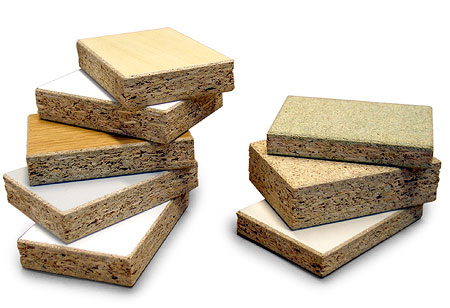Clipboards in Finland are made from sawdust. Typically the surplus of plywood manufacturing is used for chipboards. In other places, even flax stems, sugar canes or wood + other mixtures are used to make chipboards. These boards don’t look much different compared to wood chipboards. The chipboards made from flax stems are fairly light and tough, suitable use is for example as a table top.

Chipboards are made by clueing small pieces of sawdust together. The surface layers are fine sawdust and the middle layer is rougher. Chipboards don’t have grains. The strength is the same from every direction. It can be used and glued just like normal wood.
The chipboard is often glued with urea formaldehyde resin, this means it doesn’t withstand moisture and is only suitable for indoors. Decades ago the formaldehyde from the glue caused allergic reactions in well sealed buildings. The chipboards built nowadays fulfill the E1-formaldehyde rate.
Measures
- There is no standardized normal size for the sheets of chipboard. The sizes vary in between factories. Usually the sheets are made as large as possible so that the consumer can cut them to the size they need.
- The chipboard made in Finland is made to withstand moisture better by melamine-urea-formaldehyde resin. Those boards are suitable for dry outdoors.
Chipboard usage
- Industrial furniture (cabinets, shelves and table tops)
- Structural parts in furniture.
- Building walls, ceiling and also for floors.
- Moisture withstanding chipboards are used for bathroom furniture.
- Concrete casting molds
- Certified fire retardant boards
Chipboard types
The chipboard types vary from each other by the glue type and thickness of the board. The thickness varies from about 650–750 kg per m3 which means its much heavier than normal wood.
Differences between manufacturers cause:
- The workability depends on the density of the board.
- The impurities of the board can cause damage to blades
- The warping sensitivy of the board.
The boards are grouped by their appearance. Class A and B. Class A is flawless and class B can cave minor damage on the surface.
The quality standards of a chip board is determined according to a European standard SFS-EN 312. The quality groups are devided in to seven groups and are each marked with a P-marking.
Indoor use (Humidity class 1 which means that the RH is below 60%):
- Common chipboard P1
- Furniture chipboard P2
- Tougher board for indoor use P4
- Very tough board used for flooring P6
Other chipboards
Moisture withstanding boards P5 (previously known as V313 board), can’t stand continues water stress, class 2 for construction. The boar has a greenish tone.
Wood-plasterboard (Sasmo-X) fireproof chipboard, adhesive plaster. Workable with the same tools and machines used for wood. Not as tough as normal chipboard. Also can’t stand moisture.
Properties
Good
- The same basic characteristics as wood.
- Boards don’t have grains, they withstands pressure from all directions.
- Measurements of the board don’t change much with moisture.
- Doesn’t crack like wooden boards.
- Even, supervised strength and quality class
- Ready coated board doesn’t require a finish
- Cheap and easy to find.
Problems
- Normal chip board can’t withstand moisture
- Moisture might bend the board.
- Chip board is heavy
- The middle layers of the board can’t withstand pressure: Connecting boards together requires dowel pins, hinges or other fittings on the surface of the board, not on the sides.
- The visible side of the board requires a lipping.
- Wears blades more than wood.
- Chipboard should not be burnt in a conventional oven
- The quality and former health problems from cheap furniture made from chipboard has had a negative impact on the reputation of chipboard. Even though